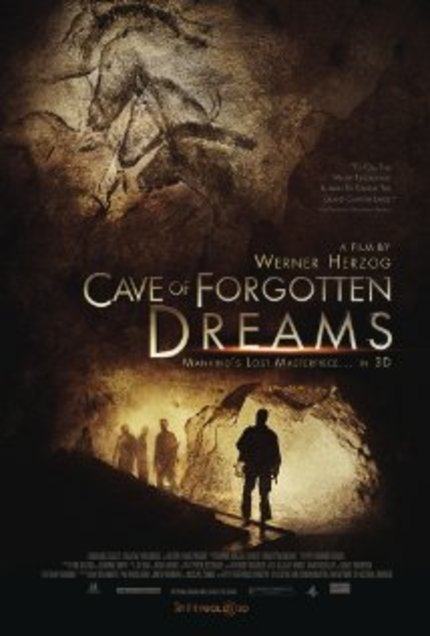CAVE OF FORGOTTEN DREAMS review

I bring this up because the new documentary by iconoclast filmmaker Werner Herzog, "Cave of Forgotten Dreams", seems to, in some ways, reflect the scenario of so effectively put forth in "Roma". Mankind has indeed recently unlocked a long-sealed chamber adorned with the artwork of a lost culture. (The Chauvet caves of Southern France.) There is little question that Herzog, the French cave overseers, et al are working to, in their own ways and via their own given methods, preserve the cave for future generations. It is Fellini's depiction of haphazard senseless destruction of disregarded history that they are working to stave off. Ironic, then, that due to the overabundance of human examination, the drawings may be suffering the cold air after all...
I'm probably in the vast minority of the general populace regarding this, but I was really looking forward to this film. Since Herzog hit the scene in the early 1970s during the fever pitch of the confrontational New German Cinema movement, his role has always been that of crazed global explorer. Herzog would take his cameras to rarely treaded parts unknown, and put his underlings through trials so rigorous, the filmmaking seemed to become secondary to literal survival. Now, much later in his high-falutin career of madness mingled with human introspection comes a documentary about an unseen cave wall covered with 40,000-year-old artwork of early mankind. And in a turn most tantalizingly weird, it's in 3-D.
Yes, Herzog in 3-D. Generally, when someone tries something that seems wildly off his or her beaten path, I'm absolutely drawn to it. Not that I'm hoping for a train wreck - absolutely not. I'm compelled by the notion of what if, just what if, they nail it? What if the artist transcends their known niche? What if, by chance, it's incredible in its freshness, its boldness? Surely Herzog, a cinema master in his own right, has a brilliant plan for artistically applying this new element to his work, and won't just be relying upon the 3-D as a gimmick to quicken the pulse-rate of a struggling finished product, right? Right??
Fascination with this aspect hasn't stopped just with me, of course. Since initial word got out that Werner Herzog was working on a 3-D documentary about ancient cave drawings, curiosity has run high. What, pray tell, could it be about this cave and/or drawings that warrants the 3-D treatment? Sure, this is historic. Sure, the drawings are 40,000 years old. But still - how would 3-D enhance audience perceptions of this... wall?
Now, having experienced the film in all its three-dimensional glory, I believe I have a grasp on what Herzog was going for. By allowing us to experience not just the drawings but the environment itself in as immediate a way as possible, Herzog is clearly hoping to share the transcendent trip back in time that he himself experienced during his own journey into the cave. Unfortunately, what he's given us is an over-extended educational film, marred by limited access to the drawings and too many talking heads.
As the director/producer/narrator is fond of telling us during the film, the drawings in this cave are quite likely the oldest artwork ever discovered. And, as far as such discoveries go, this one was relatively recent, the mid-1990s. Due to the delicate nature and age of the drawings, bureaucratic and environmental restrictions are enforced heavily. Herzog makes no secret of this throughout the documentary, reminding us occasionally that they were only allowed a few lights, a few crewmembers, and were under no circumstances allowed off of the narrow established pathway. Obviously all of this seriously binds the filmmaker's creative hands, but after a while, the attempt gives way to the unimpressive whole of the finished film, and aside from 3-D enhancement, one has to wonder if the footage that Herzog, who is widely considered one of the great living directors, came away with is that much different than any skilled videographer could capture if given the same opportunity.
Although many precautions have been taken to preserve the real-life cave drawings, we are eventually informed that mold is starting to alter them, due to the influx of outside visitors in that past decade. But seeing how this revelation doesn't come until the end, there is no felt urgency about what we're experiencing. Unlike Fellini's quickly tragic artwork disintegration, and all the emotional heft that brings, Herzog's exploration gets to feeling downright sterile, and remains as unmoving as the cave walls themselves.
There's no way around it - "Cave of Forgotten Dreams" is boring. Terminally, draggingly, boring. The subject could be an interesting one, but I suspect that once Herzog's creative visions fell victim to the heavy restrictions of the cave managers, his entire inspiration for the project became weighed down. Even his trademark bluntly Zen narration sounds more like self-parody than the transcendent directory it's intended as. (Of course, to be fair, anyone who's experienced the hilarious online videos of a Herzog impersonator reading children's books may likely have a hard time ever processing his narration in a serious manner again.)
The fact remains, however, that once again Herzog has delved into brave new terrain, both by visiting the cave, and by presenting the documentary in 3-D. Perhaps his next documentary outing will rekindle the spark he demonstrated most recently in "Grizzly Man". This time, although he's set out to transcend time and history in three dimensions, he just ends up hitting the wall.
- Jim Tudor
Cave of Forgotten Dreams
Director(s)
- Werner Herzog
Writer(s)
- Werner Herzog
Cast
- Werner Herzog
- Jean Clottes
- Julien Monney
- Jean-Michel Geneste

Do you feel this content is inappropriate or infringes upon your rights? Click here to report it, or see our DMCA policy.






